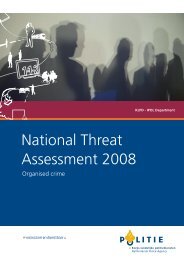Assessing the Effectiveness of Organized Crime Control Strategies ...
Assessing the Effectiveness of Organized Crime Control Strategies ...
Assessing the Effectiveness of Organized Crime Control Strategies ...
You also want an ePaper? Increase the reach of your titles
YUMPU automatically turns print PDFs into web optimized ePapers that Google loves.
<strong>Assessing</strong> <strong>the</strong> <strong>Effectiveness</strong> <strong>of</strong> <strong>Organized</strong> <strong>Crime</strong> <strong>Control</strong> <strong>Strategies</strong>:<br />
A Review <strong>of</strong> <strong>the</strong> Literature<br />
(Albanese, 1996:227). Fur<strong>the</strong>rmore, <strong>the</strong> President’s Commission on <strong>Organized</strong> <strong>Crime</strong><br />
(1986:345) has noted that <strong>the</strong> reliability <strong>of</strong> information on <strong>the</strong> seizure <strong>of</strong> non-drug assets is<br />
undermined by double counting, decentralization, and variations in data ga<strong>the</strong>ring methods.<br />
According to a study cited by <strong>the</strong> Commission (Stellwagen, 1985), more than one-half <strong>of</strong> state<br />
and local <strong>of</strong>ficials could not estimate <strong>the</strong> value <strong>of</strong> confiscated property. The determination <strong>of</strong> <strong>the</strong><br />
value <strong>of</strong> such property is an essential part <strong>of</strong> an overall analysis <strong>of</strong> <strong>the</strong> benefits <strong>of</strong> forfeiture laws.<br />
Levi (1997: 12-13) argues that <strong>the</strong> UK experience shows that <strong>the</strong> proportion <strong>of</strong> crime proceeds<br />
confiscated is miniscule—far less than one percent by his calculations—because major criminals<br />
are <strong>of</strong>ten not convicted, forfeiture proceedings may be unsuccessful, and <strong>of</strong>fenders may spend<br />
much <strong>of</strong> <strong>the</strong>ir proceeds, leaving <strong>the</strong>m with far fewer assets than pr<strong>of</strong>its from crime.<br />
An evaluation <strong>of</strong> <strong>the</strong> Australian experience also illustrates <strong>the</strong> limitations <strong>of</strong> forfeiture laws.<br />
Freiberg and Fox (2000) begin by pointing out that <strong>the</strong> determination <strong>of</strong> <strong>the</strong> deterrent effects <strong>of</strong><br />
<strong>the</strong>se laws is complex, as <strong>the</strong> effects <strong>of</strong> forfeiture must be disentangled from <strong>the</strong> effects <strong>of</strong> <strong>the</strong><br />
sentence imposed for <strong>the</strong> predicate <strong>of</strong>fence. The authors note that, in Australia, only 10 percent<br />
<strong>of</strong> all convictions are on indictable <strong>of</strong>fences—<strong>the</strong> remainder are summary convictions—and only<br />
indictable <strong>of</strong>fences can serve as <strong>the</strong> basis for confiscation applications. Thus, a significant<br />
proportion <strong>of</strong> crime proceeds acquired in <strong>the</strong> commission <strong>of</strong> federal <strong>of</strong>fences is not recoverable<br />
via <strong>the</strong> proceeds <strong>of</strong> crime legislation in that country. Just over 10 percent <strong>of</strong> cases involving<br />
indictable <strong>of</strong>fences--1 percent <strong>of</strong> all <strong>of</strong>fences--are subject to a confiscation order.<br />
In Australia, assets confiscated under <strong>the</strong> proceeds <strong>of</strong> crime legislation average between A$10<br />
and A$13 million per year (Freiberg and Fox, 2000:250). When one considers that <strong>the</strong> proceeds<br />
<strong>of</strong> crime have been estimated to be as high as $9 billion a year, well under one percent <strong>of</strong> crime<br />
pr<strong>of</strong>its are forfeited. The authors, as well as o<strong>the</strong>r commentators in Australia, assert that this<br />
record reflects a low level <strong>of</strong> enforcement <strong>of</strong> confiscation laws and a minimal incapacitation<br />
effect on crime.<br />
Fur<strong>the</strong>rmore, just a minority <strong>of</strong> <strong>the</strong> forfeitures involved persons affiliated with OC groups. The<br />
authors cite a study in Germany indicating that <strong>the</strong>re, too, <strong>the</strong> most common forfeitures involve<br />
drugs or assets used in <strong>of</strong>fences by consumers or small-scale dealers, ra<strong>the</strong>r than members <strong>of</strong> OC<br />
groups (Benseler, 1997). Fur<strong>the</strong>r undermining <strong>the</strong> effects <strong>of</strong> forfeiture laws is <strong>the</strong> gap between<br />
confiscation orders and assets actually recovered. In <strong>the</strong> UK, less than one-quarter <strong>of</strong> <strong>the</strong> funds<br />
ordered to be confiscated between 1987 and 1993 were actually recovered (Levi and Os<strong>of</strong>sky,<br />
1995:3). In Australia, <strong>the</strong> amount realized by pecuniary penalty orders and forfeiture orders was<br />
28% <strong>of</strong> <strong>the</strong> value <strong>of</strong> restraining orders (Freiberg and Fox, 2000:253). As for <strong>the</strong> costs <strong>of</strong><br />
confiscation, <strong>the</strong> Australian experience indicates that, at <strong>the</strong> federal level, <strong>the</strong> efforts are<br />
marginally pr<strong>of</strong>itable, as it is estimated that it costs roughly $75 to recover $100.<br />
30 | Research and Statistics Division / Department <strong>of</strong> Justice Canada








